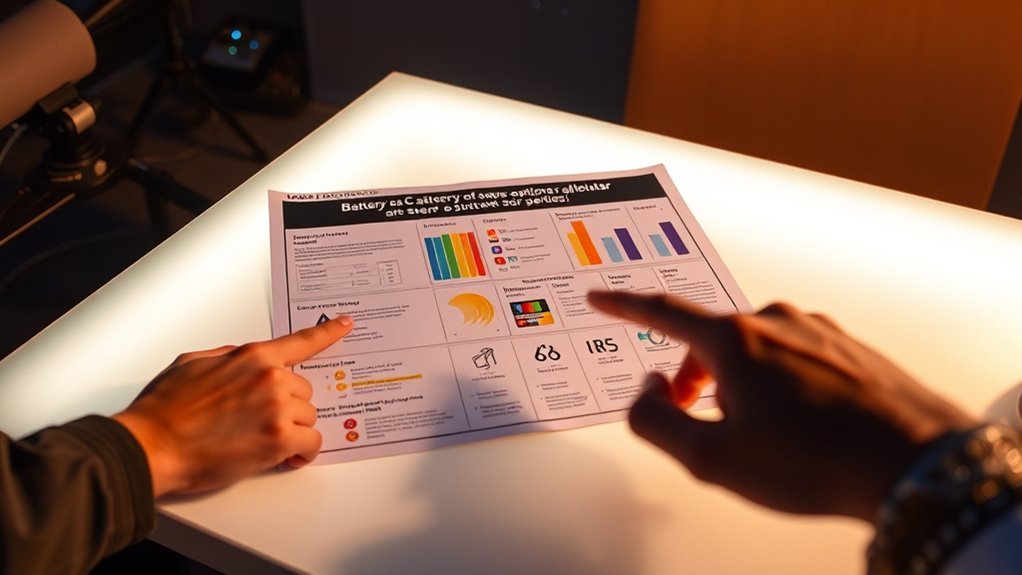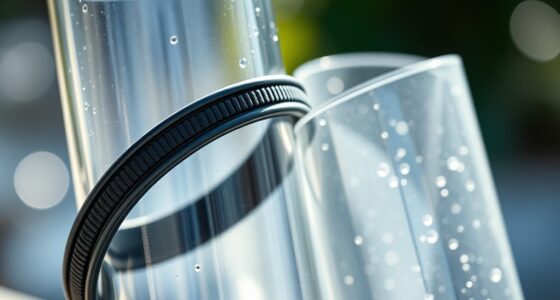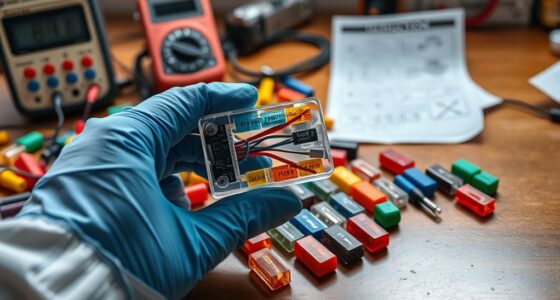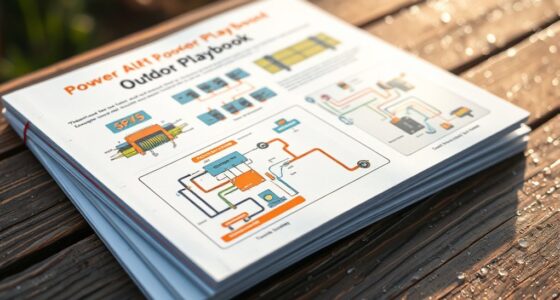If you’re planning a star party, understanding whether to use batteries or AC power can seem tricky. This guide explains how to assess your equipment’s power needs, compare different battery types, and weigh the advantages of connecting to mains power. It covers practical steps like using the calculator to estimate your energy requirements and tips for extending power during long nights. Keep going to learn how to choose the best setup for a smooth, enjoyable star-gazing experience.
Key Takeaways
- The calculator compares power needs of star party equipment to determine whether batteries or AC power are more suitable.
- Battery options vary by type (lithium-ion, lead-acid), capacity, lifespan, and portability, influencing their choice for star parties.
- AC power provides steady, reliable energy but limits mobility and requires fixed outlets or generators.
- Proper usage planning includes calculating total wattage, considering inverter efficiency, and factoring in solar recharge potential.
- Safety, maintenance, and proper equipment management are essential for extending power and ensuring smooth star party operations.
Understanding Power Requirements for Star Party Gear
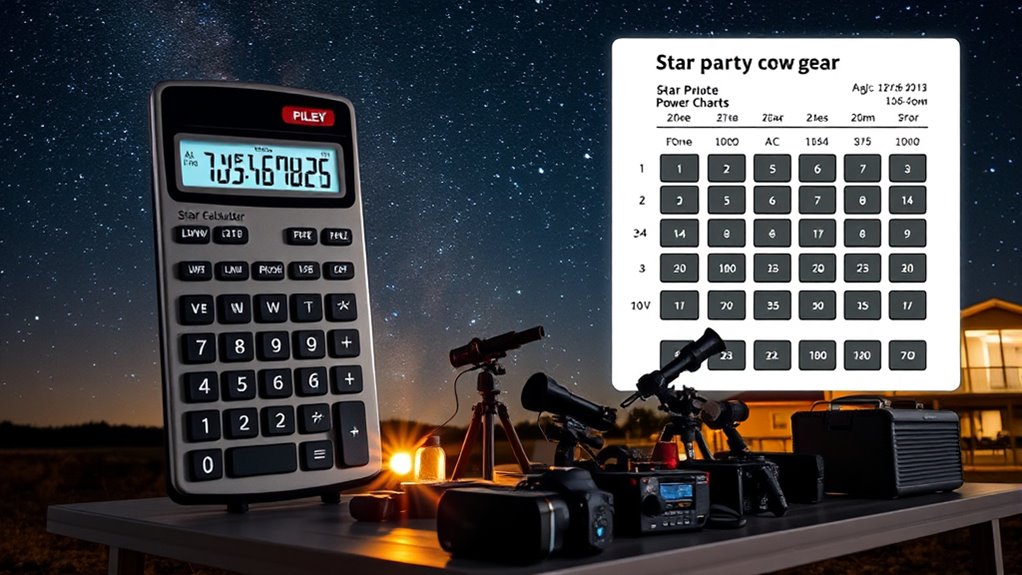
To guarantee your star party setup runs smoothly, you need to understand the power requirements of your gear. Start by checking each device’s wattage or current draw, which helps you determine how much power you’ll need. Solar energy can be a reliable source if you have enough sunlight, but you’ll still need proper power adapters to connect your equipment safely. Power adapters ensure your devices receive the correct voltage and prevent damage. Knowing your gear’s power needs helps you decide whether solar energy alone suffices or if you need additional power sources. It’s also essential for selecting the right batteries or generators. A clear understanding of battery capacity and storage helps you plan for long-term power needs during extended star parties. It’s also essential for selecting the right batteries or generators. Clear understanding of these requirements keeps your setup efficient and reduces the risk of equipment failure during your star party.
How to Identify Your Equipment’s Power Consumption
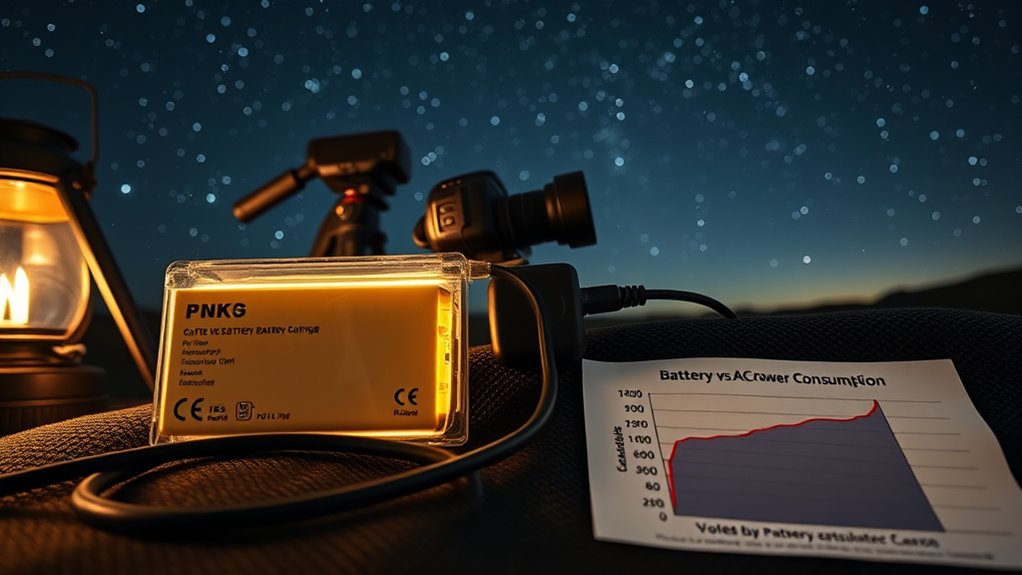
Knowing exactly how much power your equipment consumes is the first step toward planning a reliable star party setup. To do this, check the labels or manuals for each device’s wattage or amperage. Use a multimeter for accurate readings if needed. This helps with power management and guarantees your gear is compatible with your power sources. Create a simple table like this:
| Equipment | Power Consumption | Notes |
|---|---|---|
| Telescope | 50W | Check label |
| Computer | 150W | Verify with manual |
| Camera | 20W | Use rated specifications |
| RGB Light | 10W | Confirm voltage compatibility |
This approach guarantees your setup runs smoothly, avoiding overloads and ensuring you select the right power solution. Properly understanding your equipment’s power consumption is essential for efficient star party planning.
Comparing Battery Power Options and Their Lifespans
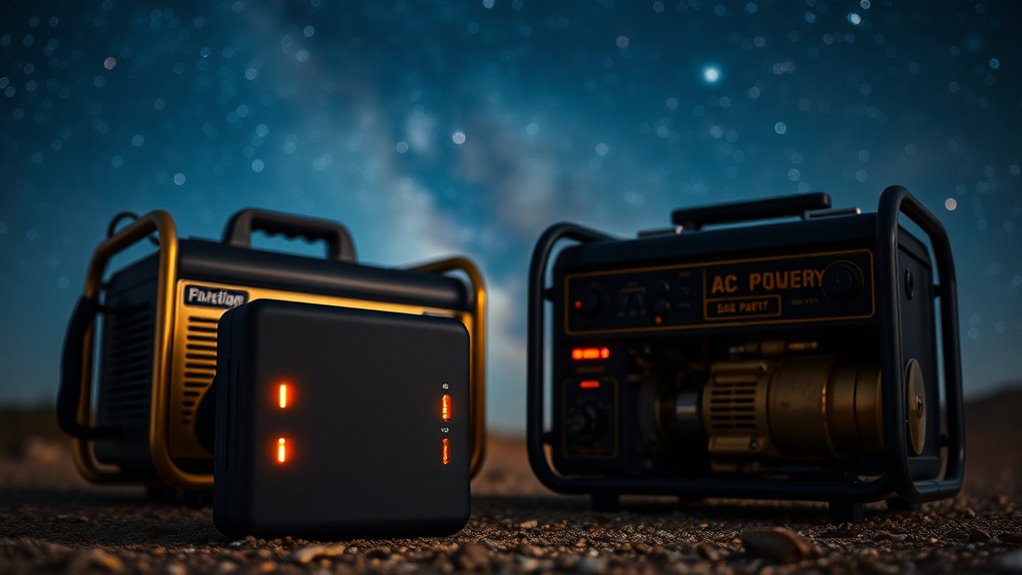
When choosing battery options for your star parties, it’s important to take into account the different types and how long they typically last. You’ll also want to think about how often you’ll need to recharge or replace them. Understanding these factors helps ensure you pick a reliable power source that fits your needs. Additionally, selecting batteries with higher energy efficiency ratings can lead to longer usage times and better performance during your events.
Battery Types and Durability
Choosing the right battery type can substantially impact your star party experience, as different options offer varying levels of power and longevity. Your choice depends on battery chemistry, which influences performance and stability. For example, lithium-ion batteries generally provide higher energy density and longer battery lifespan compared to lead-acid or NiMH batteries. Lithium-ion batteries are lightweight, recharge quickly, and last through multiple cycles, making them ideal for extended star parties. Conversely, lead-acid batteries are more affordable but tend to have shorter lifespan and are bulkier. Understanding these differences helps you select a battery that meets your power needs while ensuring durability throughout your event. Picking the right chemistry guarantees consistent power, reduces replacement costs, and maximizes your star gazing experience. Additionally, advancements in AI-enabled battery management systems are improving battery efficiency and safety, ensuring more reliable power sources for outdoor activities.
Estimated Usage Duration
Estimating how long your battery will last depends heavily on the type you select, as different chemistries provide varying lifespans under similar loads. Your usage duration also hinges on factors like inverter efficiency, which affects power transfer, and the quality of your solar panels, influencing recharge times. High-quality solar panels can extend your operating time by supplementing power, especially during prolonged star parties. Keep in mind that batteries with higher energy densities typically last longer before needing replacement, but they may also be more sensitive to temperature fluctuations. To accurately predict usage duration, consider both the battery’s capacity and how efficiently your inverter converts stored energy into usable power. Proper installation and maintenance are essential to maximize battery lifespan and ensure reliable performance throughout your star-gazing session.
Charging and Replacement
Different battery types offer varying lifespans and maintenance needs, so understanding their charging and replacement cycles is crucial for reliable star party power. Many batteries can be recharged using solar panels, which extend their usability and reduce reliance on grid power. Keep in mind that inverter efficiency impacts how effectively stored energy converts for your devices—lower efficiency means more energy loss during charging and discharging. Regularly monitor your batteries’ charge levels to prevent deep discharges that shorten lifespan. Some batteries, like lithium-ion, last longer but cost more upfront, while lead-acid batteries are cheaper but require more frequent replacements. Planning ahead with proper charging schedules and considering solar panel setup ensures you maintain power without surprises, making your star party experience smooth and dependable. Additionally, choosing batteries with appropriate capacity helps ensure you have sufficient power throughout your event.
The Advantages and Disadvantages of Using AC Power
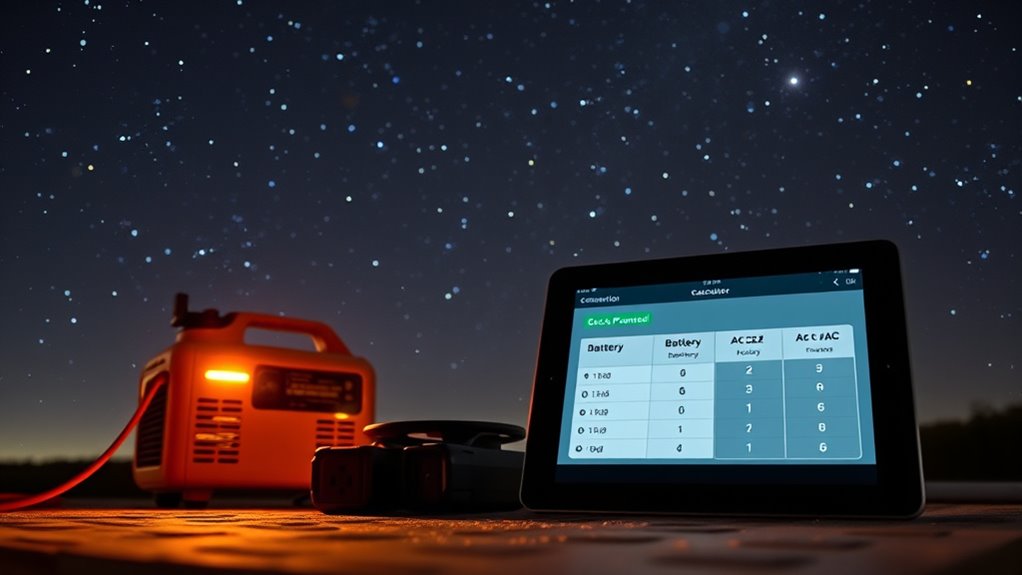
Using AC power offers consistent and reliable energy, so your equipment runs smoothly without interruptions. However, you’ll find that mobility is limited since you’ll need nearby outlets or extension cords. This trade-off can impact your setup flexibility at star parties. Additionally, during widespread outages like the recent Microsoft outage impact, reliance on AC power can pose risks if power sources become unavailable.
Power Consistency and Reliability
Power consistency and reliability are key advantages of using AC power at star parties because they provide a steady and uninterrupted electricity supply. With grid reliability, you don’t need to worry about fluctuations or outages that can disrupt your equipment or plans. This consistent power source supports your setup’s solar efficiency, ensuring your devices run smoothly even after sunset. Unlike batteries, which can drain unexpectedly, AC power supplies continuous energy, reducing downtime and maintenance. This reliability is especially important when you’re running sensitive instruments or long-exposure astrophotography gear. You get peace of mind knowing your power source won’t falter unexpectedly, so you can focus on enjoying the night sky instead of troubleshooting electrical issues. Additionally, using AC power can help maintain the color accuracy of your equipment, which is crucial for precise observations and imaging. Overall, AC power enhances stability and dependability at star parties.
Mobility and Flexibility Limitations
While AC power offers reliable electricity at star parties, it often limits your mobility and flexibility. Relying on a power outlet means you’re tethered to a fixed location, which can be restrictive when moving around or setting up in remote areas. To stay mobile, you might use solar panels paired with power inverters, but these setups require planning and space. Solar panels need sunlight and time to generate sufficient power, reducing spontaneity. Power inverters convert DC from batteries into AC, but they add weight and complexity to your gear. If you prefer freedom to explore and adjust your setup easily, AC power can feel limiting. Ultimately, while dependable, AC connections restrict your ability to quickly adapt to changing star party conditions or locations. Additionally, security considerations such as potential theft or damage to external cables may influence your choice of power source.
Step-by-Step: Using the Calculator to Estimate Your Needs
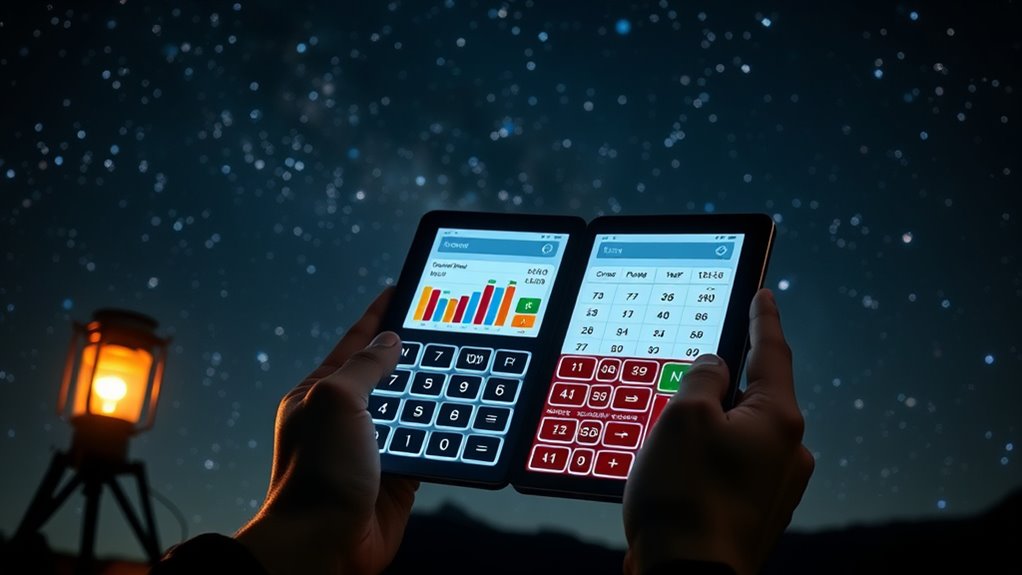
To accurately estimate your power needs with the calculator, start by gathering details about your equipment and plans. List all devices you’ll use during the star party, including their wattage and estimated run time. This helps determine your total power consumption. Focus on understanding your equipment’s battery life and power efficiency, as these impact how long you can operate on a given power source. Input the wattage and planned usage hours into the calculator. It will then help you compare whether a battery or AC power best suits your needs. Adjust your inputs if you plan to add more devices or extend your observing session. Additionally, considering the power source options available can help you make the most informed decision. This step-by-step process guarantees you select the most effective power solution, avoiding surprises during your star party.
Factors That Affect Battery and AC Power Efficiency
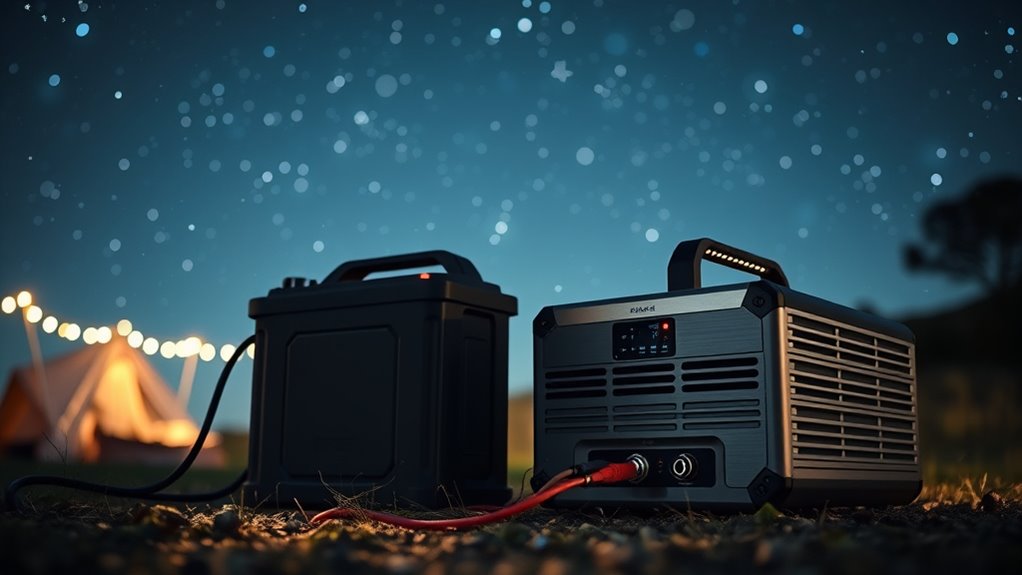
Several factors influence how efficiently your battery or AC power source performs during a star party. The quality and capacity of power banks play a significant role, as higher-quality units tend to deliver more consistent power with less loss. Solar panels, if used for recharging, depend on sunlight intensity and panel efficiency, affecting overall power availability. Temperature also impacts performance; batteries and power banks can lose capacity in extreme cold or heat. Additionally, the power draw of your equipment determines how quickly your source depletes, so energy-efficient devices conserve power. When using solar panels, regular sunlight exposure boosts recharge rates, but cloudy conditions slow this process. Understanding these factors helps you optimize your power setup, ensuring a successful, uninterrupted star-gazing experience.
Tips for Extending Power Supply During Long Star Nights
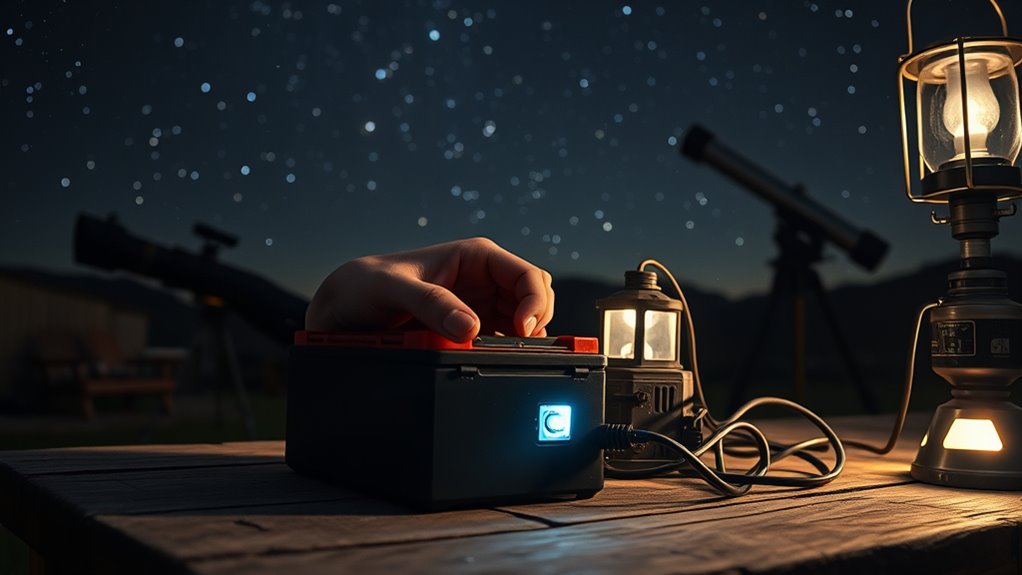
Maximizing your power supply during long star nights requires strategic planning and smart usage. To keep your equipment running smoothly, consider installing portable solar panels during the day to recharge your power storage. Use energy-efficient devices to reduce consumption and extend battery life. Keep spare batteries or additional power storage units on hand for emergencies. Shield your solar panels from dust and debris to maximize sunlight absorption. Manage your power usage by turning off unused equipment and setting devices to low-power modes when possible. Also, monitor your energy levels regularly with a reliable power calculator to adjust your plans accordingly. These tips help you make the most of your power resources, ensuring your star party stays illuminated all night long.
Common Mistakes to Avoid When Planning Your Power Setup
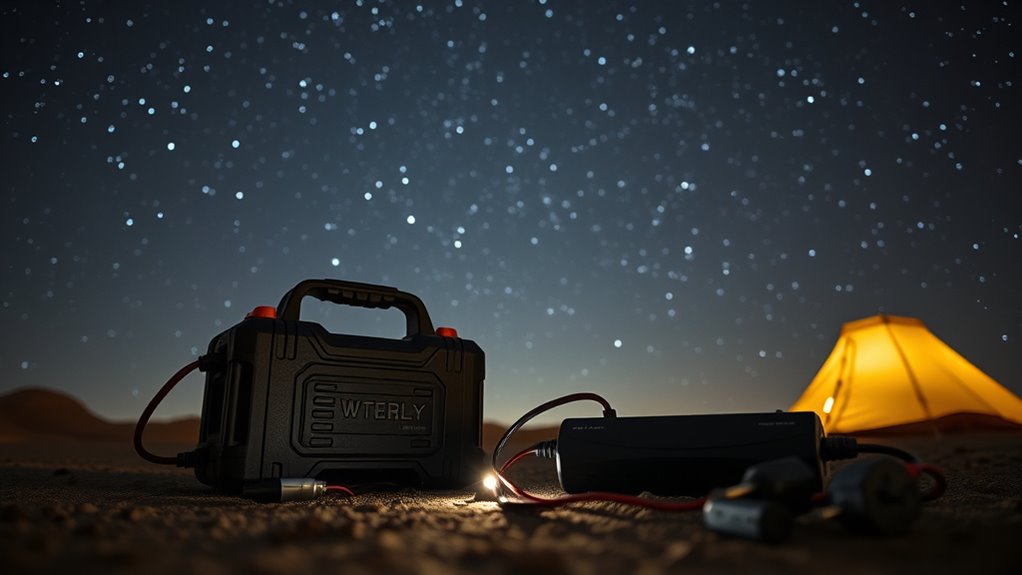
One common mistake is overlooking your actual power needs, which can leave you short during the night. Ignoring safety precautions can lead to dangerous situations or equipment damage. To guarantee a smooth experience, plan carefully and prioritize safety at every step.
Overlooking Power Needs
Overlooking your actual power needs is a common mistake that can lead to serious problems during star parties. Failing to accurately estimate how much power your equipment requires might leave you in the dark or unable to run essential devices. Imagine setting up your solar panels or connecting power banks, only to find they’re insufficient. This oversight can cause equipment shutdowns or force you to cut activities short. Visualize your setup struggling to keep up with your demands, leaving you scrambling for solutions. To avoid this, consider:
- Underestimating the wattage of your telescope and accessories
- Forgetting to account for charging devices
- Ignoring the power draw of lights and communication gear
- Not including extra capacity for potential spikes
- Overlooking the importance of reliable power banks and solar panels
Ignoring Safety Precautions
Neglecting safety precautions when planning your power setup can lead to dangerous situations and equipment damage. Ignoring safety concerns, such as proper grounding and circuit protection, risks electrical shock or fire. Using technical jargon without understanding it, like “overcurrent” or “short circuit,” can cause you to underestimate hazards. Always verify your wiring, fuse ratings, and load calculations before connecting equipment. Failing to follow safety protocols might result in equipment failure, personal injury, or worse. Don’t assume that DIY fixes or shortcuts are safe; even minor mistakes can escalate. Be diligent about inspecting connectors, using appropriate surge protectors, and adhering to manufacturer instructions. Prioritizing safety guarantees your star party experience stays enjoyable and incident-free.
Interpreting the Results: Making the Best Choice for Your Event
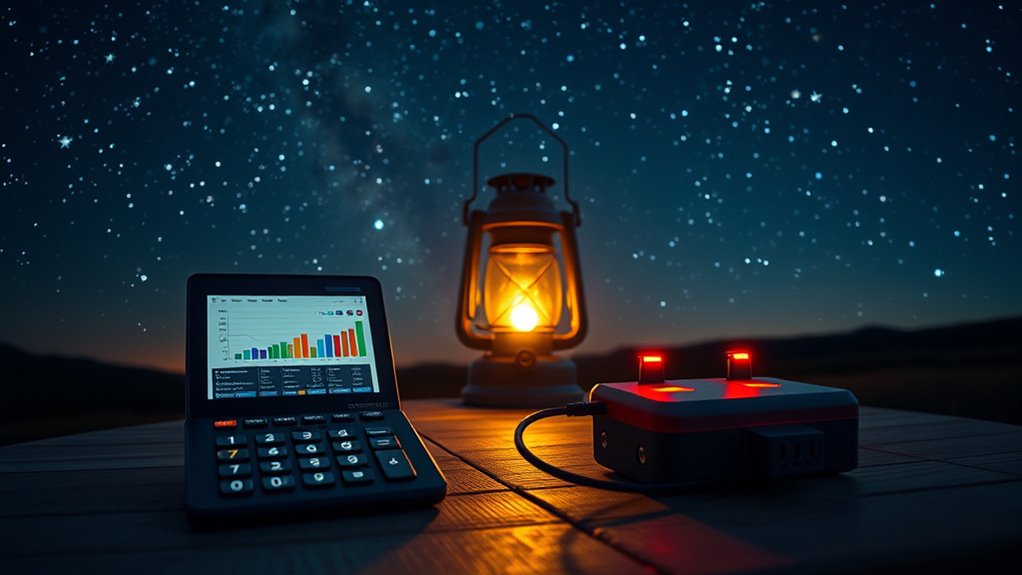
When comparing battery and AC power options for your star party, it’s essential to contemplate how each setup aligns with your specific needs and constraints. Use the calculator results to assess whether your chosen power source provides enough energy for your equipment, considering factors like inverter sizing and solar panels if applicable. Think about the duration of your event, mobility needs, and power reliability. If the calculator indicates your battery setup can sustain your equipment, that’s ideal for remote locations. If AC power is more suitable, ensure you have access to reliable connections. Remember, larger solar panels can extend battery life, and appropriate inverter sizing ensures safe, efficient power conversion. Focus on making a balanced choice that guarantees smooth, uninterrupted stargazing.
Practical Examples of Power Planning for Different Star Party Scenarios
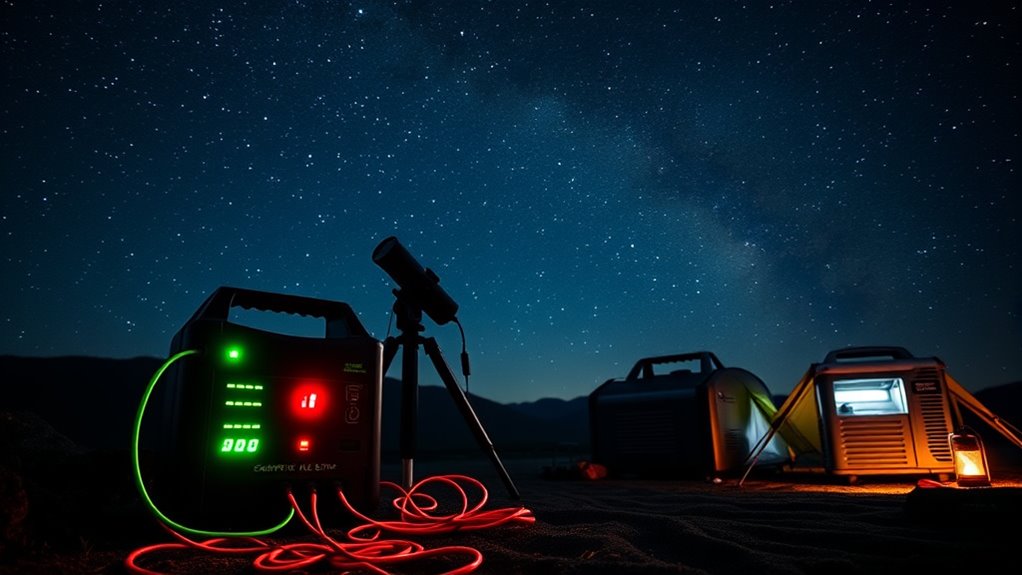
Planning power solutions for your star party depends heavily on the specific scenario you’ll face. If you’re hosting in a remote location with limited access to grid power, using solar panels combined with a reliable inverter is essential. For a small gathering with minimal equipment, a portable solar setup with inverter options tailored for low wattage might suffice. Larger events requiring more power should include bigger solar arrays and inverters capable of handling higher loads. Consider your equipment’s power needs carefully. For continuous use, batteries backed by solar panels can provide steady power without noise or fumes. By analyzing your scenario, you can select the best combination of solar panels and inverter options to ensure your star party runs smoothly without power interruptions.
Frequently Asked Questions
How Does Temperature Affect Battery Performance During Star Parties?
Temperature critically impacts your battery performance during star parties. When it’s too hot or cold, your battery’s longevity decreases because extreme temperatures weaken its chemical reactions. To keep your battery working at its best, you need good temperature regulation, especially in outdoor conditions. Maintaining a stable temperature helps preserve battery life, ensuring you have reliable power throughout your star gazing night. Always monitor and manage temperature to get the best performance from your battery.
Can Solar Panels Be Integrated Into Power Solutions for Star Parties?
Did you know that solar panels can boost your star party power setup by up to 20%? You can definitely integrate solar panels into your power solutions, enhancing efficiency and sustainability. They improve solar panel efficiency, especially during long nights, by charging batteries for backup. Just make certain your system has enough battery storage capacity to store daylight energy, so you stay powered through the darkest hours of your star-gazing adventure.
What Safety Considerations Are Necessary When Using AC Power Outdoors?
When using AC power outdoors, you need to prioritize grounding safety to prevent electrical shocks. Make sure all outlets and equipment are properly grounded, and use weatherproofing measures like waterproof covers and outdoor-rated extension cords. Keep connections dry and protected from rain or dew, and avoid overloading circuits. Regularly inspect your setup for damage, and always follow manufacturer instructions to guarantee safe, reliable power during your star party.
How Do Power Surges Impact Equipment During Long Star Nights?
A stitch in time saves nine, and that’s true for power surges during long star nights. Surges can damage your equipment, causing data loss or costly repairs. To prevent this, use surge protection devices and make sure proper equipment shielding. These safeguards absorb or divert excess voltage, keeping your gear safe. Regularly check and maintain your surge protectors for reliable performance and peace of mind under the stars.
Are There Portable Power Options Suitable for Remote Star Party Locations?
Yes, you can use portable generators and lithium batteries for remote star party locations. Portable generators provide reliable, high power output, ideal for longer nights and multiple devices, though they can be noisy. Lithium batteries are lightweight, quiet, and easy to carry, perfect for powering essential equipment without the fuss. Both options guarantee you stay connected and powered up in remote areas, making your star gazing experience smooth and enjoyable.
Conclusion
Ultimately, whether you choose battery or AC power, your star party experience hinges on careful planning—sometimes, it feels like the universe aligns to test your readiness. By understanding your gear’s needs and using the calculator wisely, you’ll find the perfect balance. After all, it’s in these small, deliberate steps that the stars seem to grant you just enough power—reminding us that even in planning, a little cosmic coincidence can make all the difference.
